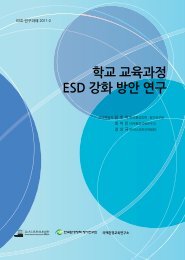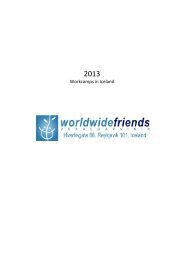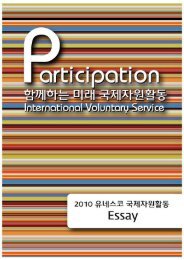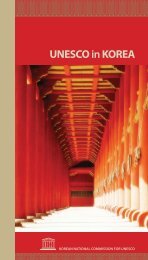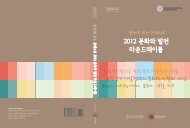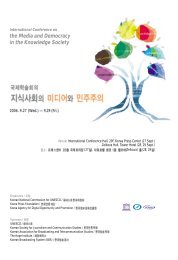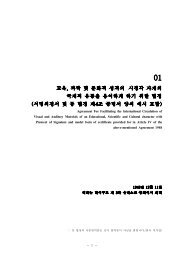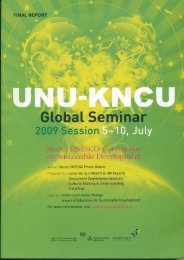DMZ ì¼ì ìí ííì ê´ë¦¬ë¥¼ ìí êµì 컨í¼ë°ì¤ - ì ë¤ì¤ì½íêµììí
DMZ ì¼ì ìí ííì ê´ë¦¬ë¥¼ ìí êµì 컨í¼ë°ì¤ - ì ë¤ì¤ì½íêµììí
DMZ ì¼ì ìí ííì ê´ë¦¬ë¥¼ ìí êµì 컨í¼ë°ì¤ - ì ë¤ì¤ì½íêµììí
Create successful ePaper yourself
Turn your PDF publications into a flip-book with our unique Google optimized e-Paper software.
FindingCommonGroundBetweenthe<br />
Two Koreas<br />
Mr. Peter Shadie<br />
IUCN Asia<br />
A normal prerequisite for successful transnational conservation is a degree of willingness<br />
from the concerned countries to cooperate in the interests of protecting shared resources.<br />
In the case of the <strong>DMZ</strong> this willingness is not equally shared between DPRK & ROK.<br />
As has been pointed out in numerous forums on the <strong>DMZ</strong>, the enthusiasm for joint<br />
conservation has largely to date come from the South. More than this, the simple capacity<br />
for ROK and DPRK field managers to even communicate is a challenge so making<br />
collaboration and joint management almost impossible. This lends a special challenge to<br />
achieving a Peace Park in the <strong>DMZ</strong>.<br />
The dialogue about conservation within the broader <strong>DMZ</strong> often raises the logic of<br />
focussing on the eastern section of the <strong>DMZ</strong> where the two protected areas of<br />
Kumgang-san and Seorak-san are only separated by the <strong>DMZ</strong> and buffer control zones.<br />
These two protected areas which exist within the shared Kangwon Province would seem to<br />
offer one of the more promising opportunities for transboundary conservation through a<br />
Peace Park.<br />
Seorak-san in ROKprotects some of Korea’s most spectacular mountain scenery and is<br />
one of the country’s most popular parks attracting over 4million visitors per year. The<br />
park protects a rich array of plant and animal species and covers nearly 40,000ha.<br />
Kumgang-san in DPRK is slightly larger at nearly 48,000ha and conserves complementary<br />
biodiversity and cultural values along the Baekdu Daegan Mountain System that forms the<br />
spine of Korea. Both these protected areas are classified as Category II under the IUCN<br />
system. Kumgang-san possesses a series of famous lakes and is, like Seorak-san, a hugely<br />
popular destination for Koreans. The park contains the Kumgang-san Diamond Mountains<br />
tourist resort established by the Hyundai Asan Corporation.<br />
In May 2010 IUCN were invited to DPRK by the Nature Conservation Union of Korea<br />
(NCUK). NCUK are an IUCN member of long standing and requested support across a<br />
range of capacity areas related to protected areas and species conservation. The visit<br />
revealed a strong appetite among Government officials and academics for technical support.<br />
IUCN have undertaken to work toward providing support although working in the country<br />
Nature, Peace and Local Development ❙ 89



